Shevlin Sebastian's Blog, page 53
August 13, 2018
When A Pen Becomes A Tree
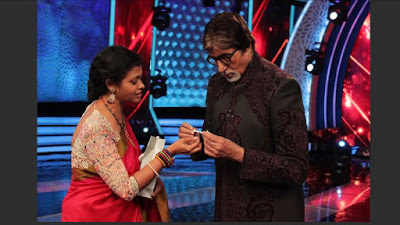
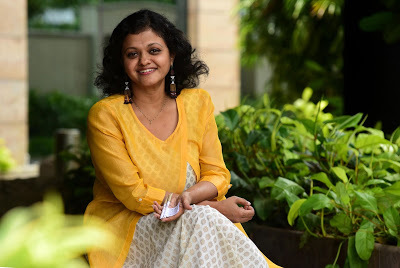
To lessen environmental damage, social entrepreneur Lakshmi Menon has invented a paper pen which has a seed at one end. Instead of discarding the pen after use, if you plant it, it becomes a tree
By Shevlin Sebastian
At a studio in Mumbai, social entrepreneur Lakshmi Menon presented actor Amitabh Bachchan with a pen. He stared curiously at it. Then he looked up and said, “What is it? Lakshmi replied, “Sir, this is a paper pen. And they are environment-friendly. At one end, there is a seed. After you finish using the pen, it can be placed in a pot or on the ground. And it will grow to be a tree.”
Amitabh nodded and said, “What a great idea, especially for India where we have an alarming plastic problem. I will publicise it.”
Lakshmi felt gratified and elated.
A little over two years ago, in a blaze of publicity, Mollywood superstar Mammootty had planted a seed. “Now it has become a 16-foot high tree,” says Lakshmi
Interestingly, she prefers to put the seed of the hummingbird tree in the pens, because it has a lot of medicinal benefits. The leaves and flowers are very good for thyroid treatment. It can also be put into curries and salads. “It is the main ingredient for many Ayurveda medicines,” says Lakshmi. “The tender portions can be used as cattle fodder, while the white bark can be made into corks.”
The pen, priced at Rs 12, is hand-made by more than a dozen women at Lakshmi's home at Kanjiramattom (25 kms from Kochi). They make around 2500 pens every day. “It is being sent all over India,” says the 44-year-old. “And to foreign countries like the United Arab Emirates, Sweden, and Malaysia.”
Lakshmi's regular customers include Wipro, National Thermal Power Corporation and the Tatas. “We are their CSR partners,” she says. “They have bought a few lakh pens in the last couple of years. The companies feel the pens give off a feel-good factor because it is about women empowerment, and saving the environment.”
Says Nithin Choudhari, Senior Executive-Operations, of the Tata Business Excellence Group, “This is a very good product. Since the 'seed pen' is always in demand, we are maintaining significant quantities in stock.”
Last year, a pharmaceutical company bought one lakh pens, which they distributed to 5000 doctors, at 200 pens each, as complimentary gifts.
The idea of inventing this pen came to Lakshmi when she came across a disturbing statistic. “There are 45 lakh school students in Kerala,” says Lakshmi. “If they are discarding two pens every month, one crore pens end up in the ground. These pens, especially those of Chinese mark, cannot be recycled.”
Another reason for her environmental consciousness was her decade-long stay in the USA, till 2008 where she worked as a designer at an art gallery in San Francisco and stayed in the celebrity enclave (Sean Penn/Sylvester Stallone/Carlos Santana) of Marin County.
“I was amazed at how caring of the environment the people were,” she says. “Even a small stream, they would try to beautify it by growing flowers along the banks. And then I would think how Kerala has so much natural beauty. We also have 44 rivers and we were just ruining it. I felt I had to do something.”
Back in Kerala, Lakshmi has pushed hard for students to use ink pens. And thanks to her efforts, the Kerala State government has adopted a Green Protocol for schools.
According to the protocol, schools cannot use disposable water bottles, paper, styrofoam, plastic cups, plates, and food packaging including aluminium and plastic bags. “Many schools have been slow about adopting the protocol because all-around awareness has not happened,” she says.
To enable that, Lakshmi approached the organisers of the Kochi Muziris Biennale and asked them whether they could make a sculpture comprising discarded plastic pens. Founders Bose Krishnamachari and Riyas Komu agreed.
“I needed 10,000 pens, but did not know how to get it,” says Lakshmi. “So I went and met Finance Minister Thomas Isaac. I asked him to put up a Facebook post asking for discarded pens which the people could send it to the Biennale office in Fort Kochi.”
The response was stupendous. In one month the office received seven-and-a half-lakh pens. In January, this year, 40 cyclists from Kozhikode brought along bags which contained one lakh pens. “The sculpture will be put up soon,” says Lakshmi.
Meanwhile, every now and then Lakshmi gets a request that gladdens her heart. “There is a family in Coimbatore who wanted to present my pens to relatives who were coming to take their daughter-in-law back home during the seventh month of her pregnancy,” she says. “So they bought 700 pens.”
Another family had designed a wedding card like a tree. And they made a slot to put the paper pen, with the dialogue, 'Let love grow like a seed'.
“One son had the name of Agastya,” says Laksmi. “So they wanted to place the agastya (hummingbird) seed in his birthday card.”
Says Lakshmi, “Life is good.”
(A shorter version was published in Sunday Magazine, The New Indian Express, South India and Delhi)
Published on August 13, 2018 01:49
August 10, 2018
Looking After Little Babies
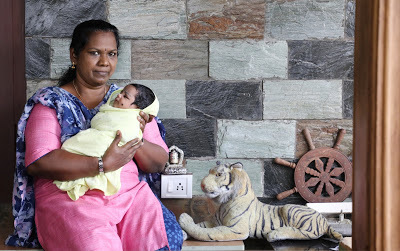
For the past several years, home nurse Mini Thomas has looked after babies from the moment they are born till about three months. She talks about her experiences
Photo by Melton Antony
By Shevlin Sebastian
It was the third child of Sona Das (name changed). She already had a boy and a girl. This one was a girl. Home nurse Mini Thomas had been hired, through the Red Cross, to look after the baby. Because of a Caesarean operation, Sona was going through a lot of pain. She was feeling angry and frustrated. “So when the one-month-old baby cried for too long, Sona would slap its wrists quite hard,” says Mini. “Then the baby would cry even louder.”
Mini told Sona not to do this. “Then I would take the baby away and say, 'Sona, what does the baby know? Why are you hitting her?'”
In Mini's 15-year career of looking after more than a hundred just-born babies, this was the only instance when a mother was cruel to her baby.
However, many mothers go through a post-partum depression. “They feel overwhelmed by the responsibility,” says Mini. “They are tired and in low spirits. Sometimes, a few mothers have told me, ‘Wish you could also breastfeed the baby’.”
It is not an easy job. In the first three months, mothers have to get up every two hours in the night to feed the baby. “They just don’t have the energy,” says Mini. “Throughout the day they feel sleepy. In fact, in the first three months, most of the time the baby is with me.” Says new mother Shwetha Vipin: “You are always feeding the child. It can be very tiring.”
But Mini also faults the young generation of mothers. “Some of them are lazy. Most of the time, they are engrossed in their mobile phone, either talking to friends or checking Whatsapp messages. After they speak for a while, they end up getting a headache. They are not supposed to speak for a long time. They also watch TV a lot.”
Another drawback of the young generation is that they do not have any patience. “They want things to happen fast, but babies are not like that,” says Mini. “They take their time. Sometimes, they will cry a lot. You have to put the child on your lap, sing lullabies and make them feel calm and loved.”
The good news is that there is no change in pride, happiness and attitude on the parents’ part whether it is a boy or a girl. “After all, it is magical, the birth of a child,” says Mini.
Most babies are born normal and healthy. But Mini remembers a boy who was prematurely born in the eighth month. “The baby weighed only 800 grams,” she says. “The mother hardly had any milk. Anyway, we fed it using small spoons.”
The boy had to be fed every hour. The mother had to physically take out the milk. All the utensils had to be boiled to get rid of germs. “We did this for two months,” says Mini. “I did not get any sleep at all. It was only in the third month that the baby had the strength to suck from a bottle.”
Thanks to her experience, Mini now gives specific tips to new mothers. “Whenever the baby is hungry, provide the milk,” says Mini. “Don't make the child cry too much.”
The mother should give toilet training to baby. “Just raise the legs, and immediately the child will pass the motion,” says Mini. “For 28 days, motion happens all the time. After that, it is about three times a day. The baby learns to do it every morning.”
Babies should be given a good feed at 9 or 10 p.m. Soon after that, it should be made to go to sleep. “The baby will probably sleep the whole night,” says Mini.
“I have taught these babies and their mothers would later tell me on the phone that their baby goes to sleep promptly after 9 p.m.”
Another tip: it is better to make the children have a bath at about 8 a.m. Children like the morning bath after a full feed.
When asked whether babies notice anything in the first month or so, Mini says, “They notice children who may be four or five years old. They also stare at the fan a lot of time. Then they will smile. Some babies will look at photos in magazines. But it is too early for them to recognise the father even if he carries the baby and kisses and cuddles it. That recognition comes later. Maybe, in the third or fourth month.”
Meanwhile, when asked what she likes about this exhausting job, Mini says, “When I look at the face of a baby, with its extraordinary innocence, I feel as if I am looking at the face of Baby Jesus. There is a divine light on their faces. It brings me a great joy.”
(The New Indian Express, Kochi, Thiruvananthapuram and Kozhikode)
Published on August 10, 2018 23:15
August 9, 2018
An Authorial Partnership
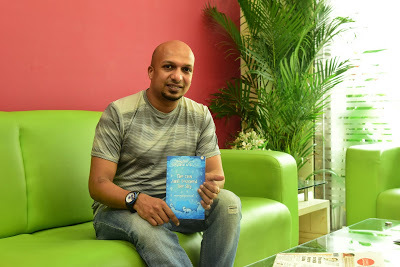
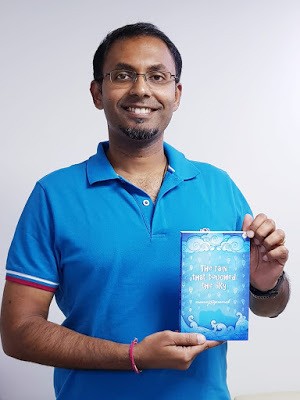
Joseph Premal Austin and Manoj N Nair, two corporate professionals, one based in Kochi and the other in Dubai, have teamed up to write a novel
Photos: Joseph Premal Austin and Manoj N Nair
By Shevlin Sebastian
Joseph Premal Austin met Manoj N. Nair when they were both studying at the SRM School of Management in Chennai. “We clicked,” says Premal. “So we became friends.” But after they graduated, they went on different career paths.
While Manoj is the general manager of an event management company in Dubai, Premal was, until recently, the CEO of a building firm in Kochi. But as the years went by, they felt that they had a dormant passion for writing. So, in 2009, they decided to write a book. While Manoj wrote some parts in Dubai Premal did the other sections in Kochi. “To discuss plot changes and character traits, we would call at night or exchange Whatsapp messages,” says Premal.
Then last year they finished the book but it was huge, at 535 pages. “Usually, for a first-time author, the manuscript should be about 250 pages,” says Premal. “So, we needed to cut down.”
This was done by the duo, along with the help of editors at the New Delhi-based Zorba Publications as well as Dr. Fr. Aniyil Tharakan, a professor of English at Mar Ivanios College, Thiruvananthapuram and Sreedevi who runs an online journal. And the author’s name on the cover is interesting: manojnpremal, with the ‘n’ standing for ‘and’.
The novel, 'The Rain That Touched The Sky' is of an 18-year-old boy called Akash who spent many years in Dubai and has come to Mumbai to do his college studies. “The book is all about his experiences in India, his relationship with his parents, friends and the society at large,” says Manoj.
Interestingly, the novel begins with a humorous incident. Akash, along with his uncle, take a crowded local train from Ghatkopar station in Mumbai. And to quote from the book: 'He was jolted when he suddenly felt a pair of soft yet tantalising mounds pressing against his back.'
“I am getting groped by a lady,” he thought. “What the hell? Which decent woman would be doing something like this? And why? Is she a hooker or something? Or is she is in so much heat? What an embarrassment!”
'It's not often that one gets groped by a woman, with her breasts pressed against his back while her tantalising fingers are playing delightful tunes of desires around his nether regions, and that too in a train.'
It is only much later, when Akash gets into an auto rickshaw, reaches his destination and attempts to pay the driver that he realises the woman who had pressed against him was a pickpocket and had taken his purse.
It is an intense novel, with many incidents described in detail. You get immersed in all what is happening, including how Akash falls in love. To give an idea, the duo has put up a trailer on YouTube. Already people from 25 countries have viewed it.
Meanwhile, when asked to compare writing to the corporate world, Premal says, “When you are working as a CEO you are working in a controlled environment. There are rules and regulations within and outside the organisation. And there is an intense competition with other companies.”
But when you are writing there are no rules. “You are the master of what you create,” says Manoj. “And you have the ability to make your protagonist do what you want. The liberty and freedom to create are unlimited and beautiful. When it results in a book, the joy is indescribable.”
Thanks to this joy, Premal now has some regrets about the course of his life. “I could have been a writer if I had not succumbed to the dictates of society,” he says. “I cannot blame anybody but myself. Society goes in a certain way. But we have the choice to follow them or go on another path. And if you go on your own path, you will feel free. To sum up, I want to be a full-time author, but it all depends on how this book fares in the market.”
So far the reviews have been good. “'The Rain That Touched The Sky has really touched my heart. It is an interesting story. The presentation and flow are amazing. The language is simple and easy to understand,” says one reviewer on Flipkart. Another wrote, “There is a good combination of gaffes, bromance and romance. The characters have several layers which are good.”
So, a corporate duo is venturing into the tumultuous and uncertain world of English writing and publishing, where the rewards are uncertain and the future can be tough, unless Lady Luck smiles on them.
(The New Indian Express, Kochi, Thiruvananthapuram and Kozhikode)
Published on August 09, 2018 01:47
August 5, 2018
Juggernaut Books Publishes My Fourth Short Story In The Erotica Series
 You can download the story on the app or the laptop.
You can download the story on the app or the laptop.Happy reading!
https://www.juggernaut.in/books/man-power-2
Published on August 05, 2018 00:34
July 31, 2018
Superstar Tales
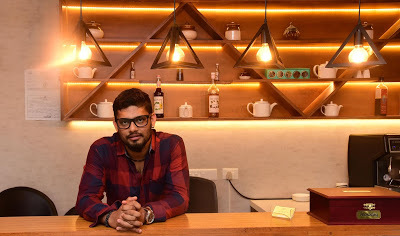
COLUMN: LOCATION DIARY
Film editor Shameer Muhammed talks about his experiences in the films, ‘Grandmaster’, ‘Jawan of Vellimala’ and ‘Ennu Ninte Moideen’
Photo: Albin Mathew
By Shevlin Sebastian
When Mohanlal came into the location set at Ernakulam for the film, 'Grandmaster' (2012), all the people stood up. However, editor Shameer Muhammed was sitting down, with an Apple Mac Book Pro on his lap. But when he saw that everybody was standing, he felt flustered and got up suddenly. Unfortunately, the laptop, worth Rs 1.5 lakh, fell to the floor and became damaged at one side.
“There is a warranty for every part, except for physical damage,” says Shameer. “I became very tense. Mohanlal saw this. He came up and spoke to me in a soothing voice, 'Let it be. Don't worry. No need to think about it'.”
Mohanlal would have long conversations with Shameer. “He asked me about my family, and who were the people at home,” says Shameer. “I told him I had only my mother. My father had passed away.”
One day, Shameer was talking to his mother Shareefa when Mohanlal came to the set. “He asked me who I was talking to,” says Shameer. “I said it is my mother.”
Mohanlal took the phone and said, “Hello Umma, this is Lal.” Shareefa immediately recognised Lal’s distinctive voice. He asked about her welfare and the family cat. “My mother felt very happy,” says Shameer.
At that time, in 2012, Facebook had taken off. Through the laptop camera, Shameer would post selfies with Mohanlal. “As a result, I would get 200 friend requests every day,” says Shameer. “Both of us would read all the comments.”
During this time, Shameer was seeing girls to get married. When he would go into orthodox Muslim households, the parents and the girl would show interest till Shameer mentioned that he worked as a spot editor in Mollywood. “They did not realise that it is a lucrative job,” says Shameer.
Because of the hectic shoot on ‘Grandmaster’, Shameer found it difficult to leave the sets. But one day, at Ernakulam, there was a gap of a few hours before the next shoot. Shameer rushed to Thrissur to meet a girl who worked in the Intensive Care Unit (ICU) of a hospital. “When my colleagues asked me where I was, I said I was meeting a girl in the ICU for marriage purposes,” says Shameer. “That went around the set like wildfire.”
When he returned, Shameer was sitting next to director B Unnikrishnan and stars like Jagathy. “They all started teasing me,” says Shameer. “Suddenly, Mohanlal Sir said, 'Your marriage will take place before September (2012). I am not just saying this for the sake of it. It will actually happen. I have predicted many marriages.”
When Lal said this it was the month of February. It was at this time, Shameer innocuously accepted a friend request from a girl called Reshma. She was an avid Mohanlal fan. Reshma requested Shameer to arrange a meeting. So, during the audio launch of ‘Grandmaster’ at Ernakulam, Reshma came and was introduced to Mohanlal. Soon, sparks flew between Shameer and Reshma. “I briefly thought about marriage but dropped the idea because Reshma is a Christian,” says Shameer. “But I remained in a confused state.”
It was at this time that the English subtitling of ‘Grandmaster’ was taking place. Shameer was assisting Latha, cinematographer Madhu Ambat's wife, and a woman called Rekhs.
“Rekhs asked me whether I had a girlfriend,” says Shameer. “I said no but there was a girl called Reshma that I liked. Rekhs asked for our sun signs. I said I am a Capricorn while Reshma is a Virgo.”
Coincidentally, Rekhs and her husband are both Capricorns. So, they got along very well. She said that Capricorn and Virgo do get along well.
“You will rarely fight with each other,” said Rekhs. As soon as Shameer heard this, he went outside, called Reshma and proposed marriage. In the end, they got married on June 11 and inadvertently fulfilled Mohanlal's prediction that he would be married before September.
Shameer has also worked with the superstar Mammootty. This was for a song in ‘Jawan of Vellimala’ but it was being shot during the Ramzan period. Shameer is a person who does not observe a fast at all. “But I was told that Mammootty Sir was very strict regarding taking fasts,” says Shameer. “He would get upset if community members did not observe it.”
So, for the first and only time in his life, Shameer began fasting. “But I managed for only five days before I began eating again,” says Shameer, with a smile.
Meanwhile, during the shoot of ‘Ennu Ninte Moideen’ (2015), at Ottapallam, it was all about eating. “On most sets, the food tastes the same,” says Shameer. “So, I would take off at lunchtime and go and eat in the local hotels. One day Jomon [T. Jomon, cinematographer] tagged along.”
There were many small hotels which were offering meals. “We would eat there,” says Shameer. “Soon, [director RS] Vimal also joined us. One day, we entered the kitchen of a hotel. Vimal is a very good cook. So, before the fish got fried, he put a lot of ginger and cumin seeds to increase the taste. Then once at a location, he got the local people to catch a few fish from a nearby river. Vimal cooked it on the bank and we ate it. It was delicious.”
(The New Indian Express, Kochi, Kozhikode and Thiruvananthapuram)
Published on July 31, 2018 23:50
July 29, 2018
Melting The Most Hardened Of Hearts
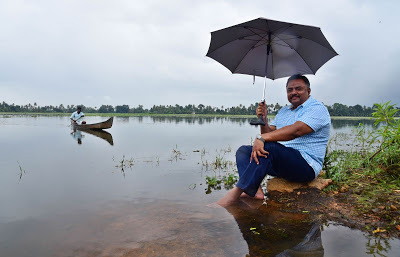
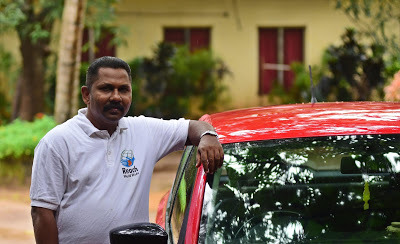
Dr Mathew Kuruvilla, of the NGO, Reach World Wide talks about their project of rehabilitating criminals
Photos: Mathew Kuruvilla; P. Lalji. Pics by Albin Mathew
By Shevlin Sebastian
It is a rainy July afternoon in Kottayam, Kerala. Standing outside his office of the NGO Reach World Wide (RWW), the founder Dr. Mathew Kuruvilla points at a canopy of trees, in translucent green that stretches hundreds of metres on the opposite side. “Isn’t it beautiful?” he says, with a smile.
Kuruvilla has plenty to smile about, apart from the beauty of nature. He is celebrating the tenth anniversary of RWW’s remarkable criminal rehabilitation programme. “More than 700 criminals have been saved,” he says. “They now lead straight lives, with a good family life and enjoy a peaceful sleep at night.”
The programme began rather accidentally. One day a woman, Anita, in Kuruvilla’s neighbourhood came and told him that when her husband Shibu would come home on parole, he would beat her up. So, Kuruvilla met Shibu in the jail and told him, “When your children grow up how will they describe you? Won’t they say, ‘My father is a criminal as well as a murderer’?”
It was a stunning opening gambit. Shibu grabbed Kuruvilla’s feet and said, “Sir, please save me.” Kuruvilla replied, “I will. Remember Shibu let us try to leave good footprints behind in our lives.”
And thus the programme began. The convicts are taught that when calls come from their former associates, they should politely say that they will call back and cut the call. “Most of the time when they start drinking they have a tendency to meet old friends,” says Kuruvilla. “This happens in the evening. So at that time, we conduct a lot of activities to divert their attention.”
Also, to convince them, RWW uses former prisoners as counsellors. “The just-released prisoners listen far more carefully to former convicts,” says Kuruvilla. “Eventually, they feel emboldened to go down the straight path.”
One man who did so was P. Lalji, a stocky forty-year-old. At the RWW office, he recounts a memory from his youth: it was a Good Friday afternoon. From a distance, Lalji saw Manoj. He moved forward and in one smooth movement, he swung the sickle on Manoj’s arm. Apparently, Manoj had attacked Lalji’s father regarding a debt and the son had taken revenge.
In the end, Lalji used the sickle 30 times. Lalji was duly arrested and sent to jail. But there was nobody to come forward as a witness, thanks to Lalji's political connections. So, the case fell apart. Thankfully, Manoj survived. So, Lalji was freed after a few weeks.
But for the next sixteen years, Lalji went in and out of prison. “Many a time I did the dirty work of political parties, as a member of a gang,” he says. “Then people would give us money to harass and intimidate their rivals. It was easy cash, but there was no peace of mind. At night if I heard an unusual sound, I would wake up, my heart beating fast, imagining that it was an enemy coming to kill me or a policeman out to arrest me.”
In the end, Lalji got tired of this violent life. It was at this moment he met Ranjit Mathew, a staffer for RWW. “He told me that my life's path was not correct,” says Lalji. “Ranjit would come to my house often and talk to me. Slowly, I was able to break away from my criminal activities and my addiction to alcohol and marijuana.”
Good luck continued for Lalji. One day, a woman, Manju, who was working in Saudi Arabia heard about Lalji's story from a friend. Amazingly, she quit her job, came to Kottayam, met Lalji and said she would marry him. Lalji accepted the proposal and today they have two children, a girl, Abigail, 9, and a boy, Abhishek, 5. “God has been kind,” says Lalji.
Incidentally, apart from prisoner rehabilitation, RWW also has programmes for women empowerment, feeding the hungry, building houses for the poor, and cleaning the environment. “We depend on donations for our works,” says Kuruvilla.
How it began
RWW began in July, 2004 because of a specific incident. One night, a local acquaintance Samuel Thomas (name changed) came to Kuruvilla for monetary help. Unfortunately, Kuruvilla did not have any money. This man had been a successful businessmen but his company had gone bust.
Samuel began working in the same company which he had owned at Rs 150 a day. But the creditors would take whatever money he earned. Samuel told Kuruvilla he could not bear the sight of his children going hungry. The next morning Kuruvilla learnt that Samuel had committed suicide. “I decided then and there I would do whatever it takes so that nobody goes hungry,” says Kuruvilla.
He also had a personal experience of suffering. When Kuruvilla was 13, his father died suddenly of a heart attack. As the eldest child, the responsibility fell on him. “I had to look after my family which included eight members,” he says. “I went to school but in the evenings I worked as a door-to-door salesman. The rejections, the 'Get outs' that people shouted at me, it was all very painful. But, as a result, I understand keenly the pain of others.”
When ex-prisoners ask Kuruvilla, why they went through such harrowing experiences, the latter says, “If you don’t go through the pain of that situation how will you know the pain of others? How will you know the pain of rejection? I tell them they have now discovered their purpose in life.”
Published on July 29, 2018 23:16
July 24, 2018
Signs From The Universe
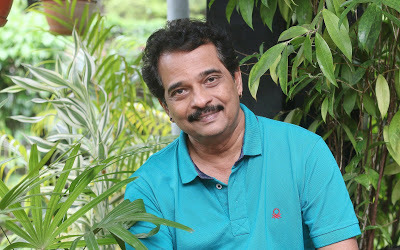
COLUMN: LOCATION DIARYDirector Jayaraj talks about his experiences in the films, 'Johnnie Walker', ‘Bhayanakam’, ‘Ottal’, ‘Vidyarambham’ and 'Kudumbasammetham'
Photo by TP Sooraj
By Shevlin Sebastian
The start of the shooting of the film, 'Johnnie Walker' (1992), took place in Bangalore. It was a time when there was trouble between Karnataka and Tamil Nadu over the sharing of the Cauvery waters. Many Tamil Nadu registration cars were set on fire.
Director Jayaraj was shooting a song called ‘Minnum Palunkukal’ inside Christ College at midnight. There were 1500 junior artistes present, which included a few Tamilians. “I was filming a stage show where Mammootty was singing,” says Jayaraj. “Soon, we heard that a mob had gathered outside the gates. They started throwing soda bottles and bricks. We could see this. It was a panicky situation.”
Jayaraj stopped the shoot. Mammootty was herded inside a room in the college, while security guards stood outside. “We called for police help,” says Jayaraj. “Thankfully, the protestors did not enter the campus.”
In the Pemandu hill, near Ooty, for the picturisation of the song, 'Poo Mariyil', for the same film, many buffaloes along with carts had been requisitioned. One evening, a young helper took a few buffaloes to the lake at the bottom of the hill to give them a wash. “Somehow, one buffalo gave him a kick and the boy slipped and fell into the water,” says Jayaraj. “And since he did not know swimming he drowned. It was a tragedy.”
Throughout the shoot, there were other disturbing events. There was a scene when Mammootty was supposed to be thrown off a bike at high speed. A stunt driver did the scene. “Unfortunately, when he fell from a height, he hurt himself,” says Jayaraj. “He had to be rushed to the hospital.”
Later, in Cubbon Park, there was a night scene where a group of youngsters were riding bikes. To stop them, several beer bottles were rolled across in a bid to stop them. Unfortunately, one bike skidded and it came and hit the camera and the rider was injured too.
Jayaraj pauses and says, “I am convinced there are negative forces in the universe.”
But there are positive forces, too. In ‘Bhayanakam’ (2017), there was a scene where Renji Panicker as a postman returns home when suddenly a stray brown dog accidentally enters the frame. “When I looked through the camera lens, it seemed appropriate,” says Jayaraj. “After the first scene, we gave the dog biscuits in the hope that he would stay. Instead, it vanished.”
There were four major scenes when the dog came in and it was always at the right time. “There was one scene when the postman is leaving his place and I felt the presence of the dog would be appropriate. And suddenly, it appeared,” says Jayaraj. “Later, I felt that Nature and some power in the Universe had helped me during the making of the film.”
In the film, ‘Ottal’ (2015), while on a location search, Jayaraj decided that if he spotted somebody who would suit the role, he would select him. One day, next to a river, he saw a man rowing a boat. “And I immediately realised that he would be suitable to play the grandfather’s role,” says Jayaraj.
This film is about a young boy and his relationship with his grandfather. The boatman’s name is Kumarakom Vasudevan. He is a fisherman in real life and ended up playing the role.
These accidental discoveries were there from the start of Jayaraj’s career. “In my debut film, ‘Vidyarambham’, I wanted to place a school against the backdrop of a few hills,” he says. So, he along with a few crew members travelled around in Palakkad for several days. But they could not find what they were looking for.
However, one day, in Muttikulangara, Jayaraj was going down a road, when he spotted a narrow lane. He asked the driver to turn into it. “It led us to the perfect location I had in my mind,” says Jayaraj. “I was shocked. I now firmly believe what the author Paulo Coelho had once said: ‘When you want something, all the Universe conspires in helping you to achieve it'.”
Sometimes, the Universe also gives an advance warning. In the film, 'Kudumbasammetham' (1992), the climax was supposed to take place at the Thyagaraja Aaradhana Temple at Thiruvaiyaru. But the authorities for various reasons did not allow the shoot to take place. Monisha Unni had a role in it.
“While the arguments were taking place, we had taken shots of Monisha as she had to leave to Chennai the next day to catch a flight to Dubai for a programme,” says Jayaraj. “In fact, her last dialogue was 'I don't have the luck for anything'.”
Unfortunately, two weeks later, on March 5, 1992, Monisha died in a car accident at Cherthala. “When I heard the news, I immediately remembered her last dialogue,” says Jayaraj. “It seemed as if the Universe was telling us something. It was almost like a farewell.”
(The New Indian Express, Kochi, Thiruvananthapuram and Kozhikode)
Published on July 24, 2018 23:25
Flowering Under A Genius

Shashaa Tirupati, the Indo-Canadian singer, who has just won a National Award for Playback Singing, talks about her career in singing South Indian songs and her association with music maestro AR RahmanBy Shevlin Sebastian
At the Reliance music studio in Mumbai, Oscar winner AR Rahman was playing the piano. A group of six girls were singing along. They had come for the audition for Rahman's show in the Coke Season 3 programme. Suddenly Rahman stopped playing and said, “Which one of you is Shashaa [Tirupati]?” There was a pin-drop silence. “It was a heart attack moment for me,” says Shashaa. “I thought he would not select me.” Shashaa raised her hand. Rahman looked at her and then looked away.
Later, during a break, Shashaa asked Rahman whether she had performed badly. He said, “Oh no. Actually, one of my assistants played me your work and I feel your voice sounds like a musical instrument.”
At that point, Shashaa did not know whether it was a compliment or not. But a month after the shoot, Shashaa got a call from Rahman's studio in Chennai. “He wanted me to sing for one of his songs,” says Shashaa in her hotel room at Kochi, where she had come to take part as a member of Rahman's troupe at a show last month.
There was an easy smile on her face when she says this. Of course, Shashaa has plenty to smile about. Recently, she won the National Film Award for Best Female Playback Singer for the Tamil song 'Vaan Varuvaan', which was composed by Rahman. And she remembers clearly what Rahman had told her when she received the award. “He said, 'Don't let these awards and accomplishments be the governing factor in what you do',” says Shashaa. “Mr Rahman wanted me to remain focused on the singing. And that is a beautiful wisdom.”
Incidentally, apart from singing several songs in Tamil for Rahman, Shashaa is also adept at singing in Malayalam, Telugu, Kannada, Punjabi, Konkani Bengali English and Hindi. Some of the songs have done well. The 'Humma Song' from the Hindi film, 'OK Jaanu' was one of the highest ranking songs on YouTube and was viewed more than 200 million times.
This is a career which Shashaa could not have envisaged when she was growing up in Vancouver, the child of Indian immigrants. Her parents loved Hindi music, so Shashaa listened to songs from the 1950s to the 70s.
One day when she was five years old, she sang Lata Mangeshkar's 'Jao Re'. “My mum was like, ‘What?!’” says Shashaa. “She ran and called my father. My dad was also shocked. Then they decided I should get proper training.”
So, from the time she was eight years old, Shashaa was taken to India during the vacations and studied classical Hindustani music. However, there were several years of struggle before she got the breakthrough with Rahman....
(Sunday Magazine, The New Indian Express, South India and Delhi)
Published on July 24, 2018 00:27
July 22, 2018
A Symbol Of Hope And Pain


Kashmiri artist Insha Manzoor's installation at Fort Kochi takes inspiration from the fishermen of the backwaters
By Shevlin Sebastian
As the visitor stepped into the first-floor hall at the Pepper House at Fort Kochi, he was immediately struck by the installation placed in the middle. It was shaped like a large barrel, with pieces of fluffy cloth surrounding it. It looked like snowflakes, but it was actually a fishing net.
The other materials used included floaters, translucent fabric as well as fishing hooks. Within the installation, there was a boat in multi-coloured sheaves of cloth.
High up, the ceiling had blue lights. It gave off a feeling of tranquility and apprehension at the same time.
The 30' x 10' installation is called 'Trapped, not defeated'. “This is a symbol of my own psyche,” says the Kashmiri artist Insha Manzoor. “I feel trapped by the memories and emotions and the conflicts which are taking place in Kashmir.”
Asked why she tied up the net in knots, at different places Insha says. “When we go to sacred places in India, people tie knots with thread and fabrics on the windows of the holy structure. My mother also used to put a knot in her saree. It is a symbolic sign of wishes that have not been fulfilled. So, the knot is a symbol of hope, as well as pain.”
As people gaze at the work, soft meditative music can be heard on the sound system. Soon, the clear voice of Insha can be heard as she recites a poem:
'There’s a light that shines in the darkness.
There’s a destiny waiting at the end of the road.
There’s meaning in the middle of this emptiness.
There’s a reason you’ve been asked to carry this heavy load.'
“This is a poem written by the American poet Justin Farley,” says Insha, who also recited a few lines from the great Persian poet's Rumi's book of poems, 'Masnavi 1'.
Insha did not have to go far to seek inspiration for her work. Serving a one-month residency given by the Kochi Muziris Biennale, Insha would come to her studio on the first floor of Pepper House. When she gazed out of the window every morning and evening, she would see the fishermen do their work in small boats in the backwaters.
“It made me feel nostalgic as I remembered the shikharas (houseboats) on Dal Lake [in Srinagar]. Boats, for me, are a metaphor about the journey of life,” she says.
Even as the 26-year-old is adept at making installations, Insha also works in mixed media, acrylic, fabric, textiles, threads, and beads. She also makes videos on different subjects. “My themes reveal a desire for hope and a world without conflict,” she says.
And she is a precocious talent. At age 13, Insha, who is originally from Mattan in Anantnag district, held her first exhibition. Thus far, she has held numerous solo and group exhibitions. She has done a four-year course in Fine Arts from the Institute of Music and Fine Arts, Jammu University.
Insha also did a two-year Master’s degree of Fine Arts (Painting) at Visva-Bharati University at Santiniketan. “It was while staying there I came across many international artists and their works,” says Insha. “It was an eye-opener for me.” At present, Insha is doing a Double-Master’s degree in painting at the Royal College of Art London. She got entry by availing of a career development loan from JK Bank as well as a grant of Rs 20 lakh from the Kashmir government.
Meanwhile, at Kochi, when she would tell people that she is from Kashmir, their eyes would widen in wonder. “They told me that Kashmir is a paradise on earth, and I would agree,” says Insha. “Then they asked me about the problems that are taking place and I would talk about that. It was heartening that many showed empathy for our difficulties.”
(Sunday Magazine, The New Indian Express, South India and Delhi)
Published on July 22, 2018 23:28
July 21, 2018
All Things Bright And Tasty
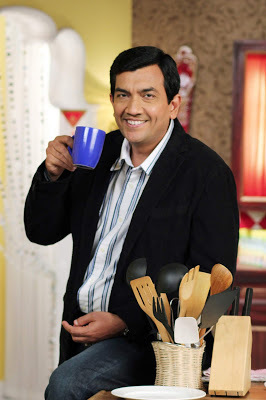
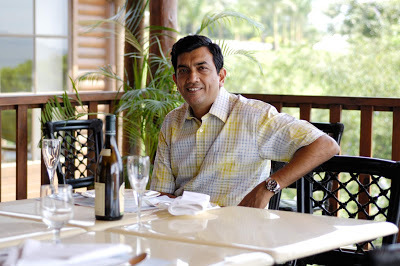
Chef Sanjeev Kapoor talks about his passion for food even as he inaugurates ‘The Yellow Chilli’ restaurant at the Lulu Mall, Kochi
By Shevlin Sebastian
It was their last shopping trip at the Lulu Mall, Kochi before Shyama from Chandigarh and her friend Insha from Jammu boarded the flight to Delhi. As they wandered around the Food Court, they suddenly saw celebrity chef Sanjeev Kapoor giving an interview in front of 'The Yellow Chilli' restaurant. They got very excited. Since the entrance was barred with a red rope, they called out to a manager who said he would not be able to interrupt the interview. But they replied that they had a flight to catch.
Thankfully, through the corner of his eye, Sanjeev saw them and waved for the duo to come over. They rushed up and shook the chef’s hand. Then they told him they were regular visitors at his Yellow Chill restaurants in their states. Selfies were taken with Sanjeev and the pair left with happy smiles on their faces.
It showed grace on Sanjeev's part. He had come to Kochi to officially inaugurate the restaurant on July 9. But the restaurant had a soft launch in November 2017. “It is doing very well,” says sales manager G. Anil Kumar. “Our clientele consists of North Indians who live in Kochi as well as many affluent Malayalis. We also have many Mollywood stars like Asif Ali as our customers.”
The food is North Indian: paneer tikka, sarson ke saag, murgh malai kofta, fish tikka, tandoori pomfret, green chilli chicken and mutton chops, among many other dishes.
The reviews have been positive. Says a visitor Priyanka Bose: ‘The flavours are very Indian, earthy and simply delicious. I wanted to try more of the main course, so, feasted on the uber-popular Lalla Mussa Dal, Meen Moilee and Fish Caldine (satisfied my affection to fish, totally!), Prawn Hara Masala (must-try) with Lachcha Paratha and the fancy Tomato Cheese Naan.’
Asked whether 'The Yellow Chilli' is different in Kochi, as compared to the 70 other Chilli restaurants worldwide, Sanjeev says, “We don’t want it to be different. But we would also like to use local ingredients, because the food has to be fresh. However, some ingredients are used everywhere. For example, turmeric, which is supplied to our Santa Clara restaurant in the USA, in Mumbai and Kochi is probably from Salem.”
Interestingly, he says, there is a common taste all over the country. “India’s taste is khatta (sour), meeta (sweet), tikka (chilly) and namkeen (salty)," he says. “A combination of this can be seen across all states.”
Sanjeev elaborates further: “Everybody uses the same chilly, turmeric, ginger and coriander. Only the proportions are different. You may use mustard oil in north India, while in Kerala it is coconut oil.”
Sanjeev is also a fan of Kerala cuisine. “It is the birthplace of spices and has perfumed not only India but the world,” he says. “There is a lot of seafood, coconut and rice, as well as Malabar parathas. There is also a sweet pasta called aada, a mixture of jaggery and coconut.”
The food of the Syrian Christians has Portuguese and Dutch influences. “Because of that it is unique, and has its own rich heritage,” says Sanjeev.
Sanjeev is one of India’s most famous chefs. His long-running TV show ‘Khana Khazana’ has been broadcast in 120 countries and has more than 500 million viewers. He also launched his own Food Food channel, in January 2011.
Asked the reasons behind his success, Sanjeev says, “You have to apply your skills, surround it with knowledge, have a great value system, which includes honesty. Don't harm anybody. Be disciplined, truthful, and think positively all the time.”
And you must take advantage of opportunities. “Opportunity knocks on the door for all people,” he says. “Some people open the door, while other's don't. Those who open the door have a better chance of success.”
Like most people, Sanjeev accidentally fell into a profession that he loves dearly. “I wanted to do something different,” he says. And unlike most people, he was successful from the very start. At the age of just 28, he won the Best Executive Chef of India Award given by the Indian Federation of Culinary Associations at an award ceremony at Geneva. He has also brought out many cookbooks. And in 2017, he was awarded the Padma Shri.
“Life is good,” he says, with a smile.
(The New Indian Express, Kochi, Thiruvananthapuram and Kozhikode)
Published on July 21, 2018 04:05



